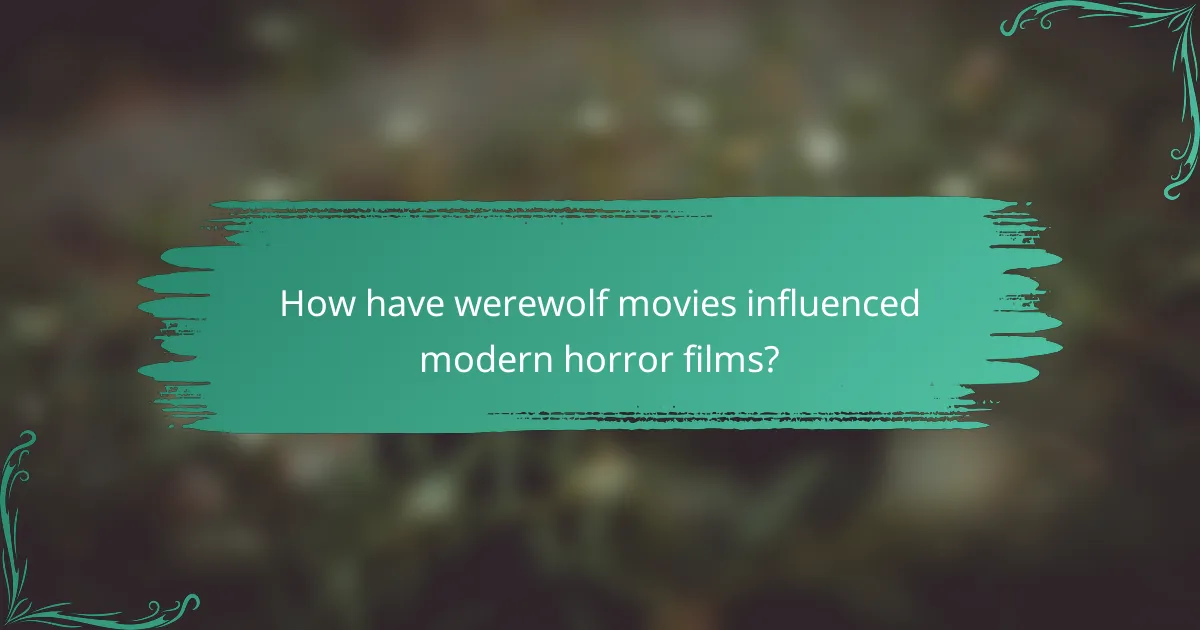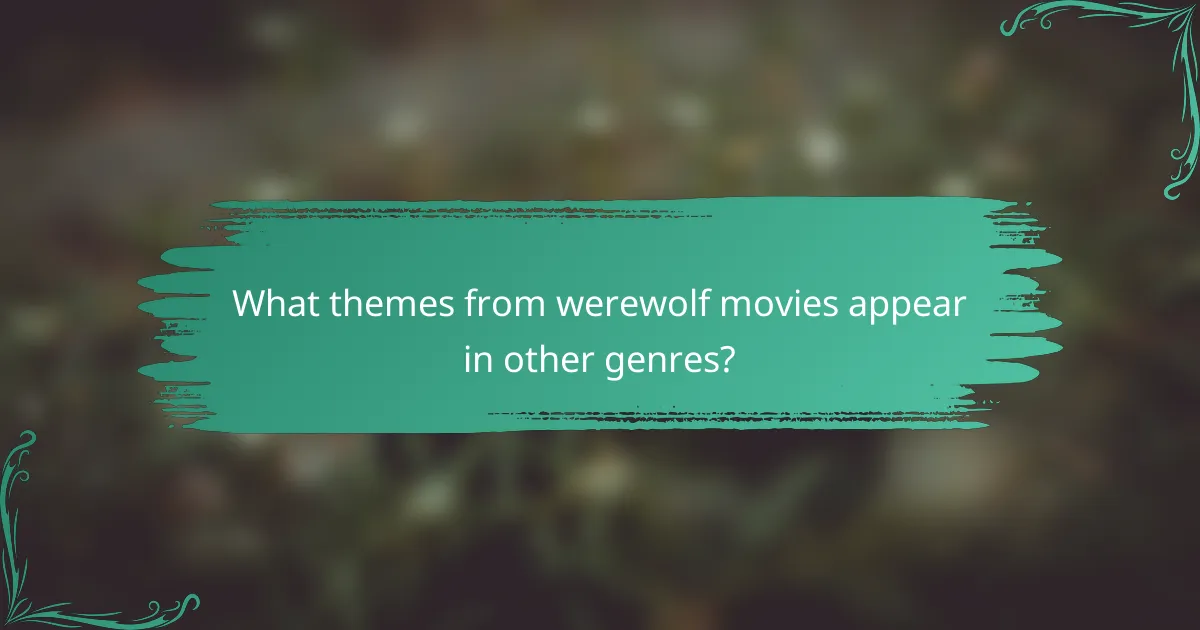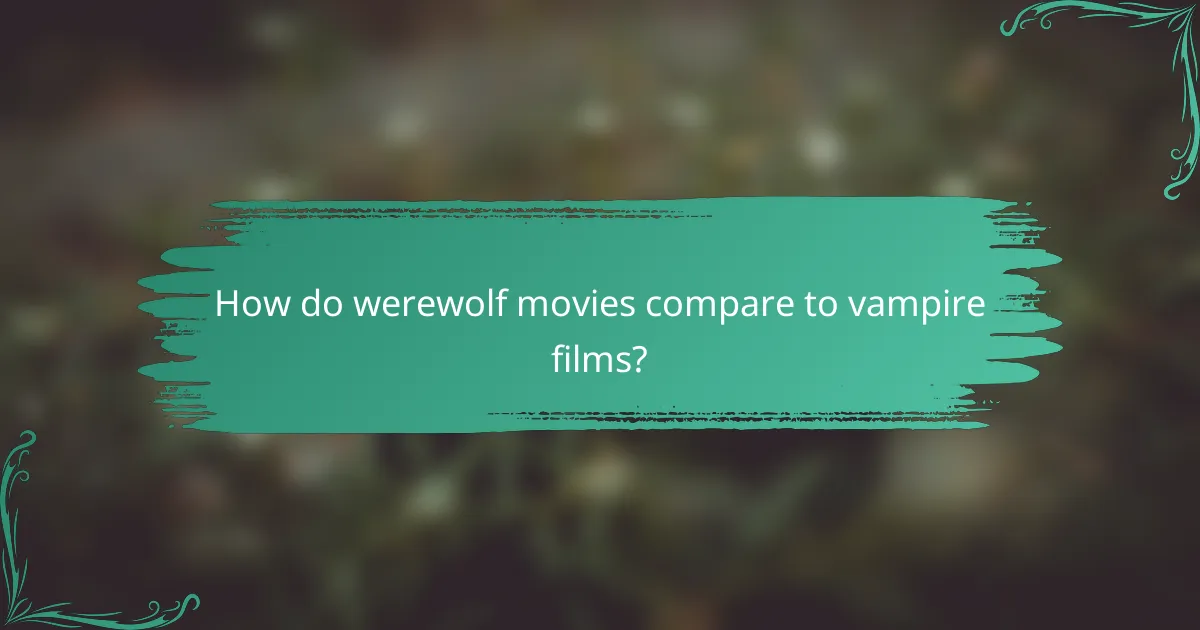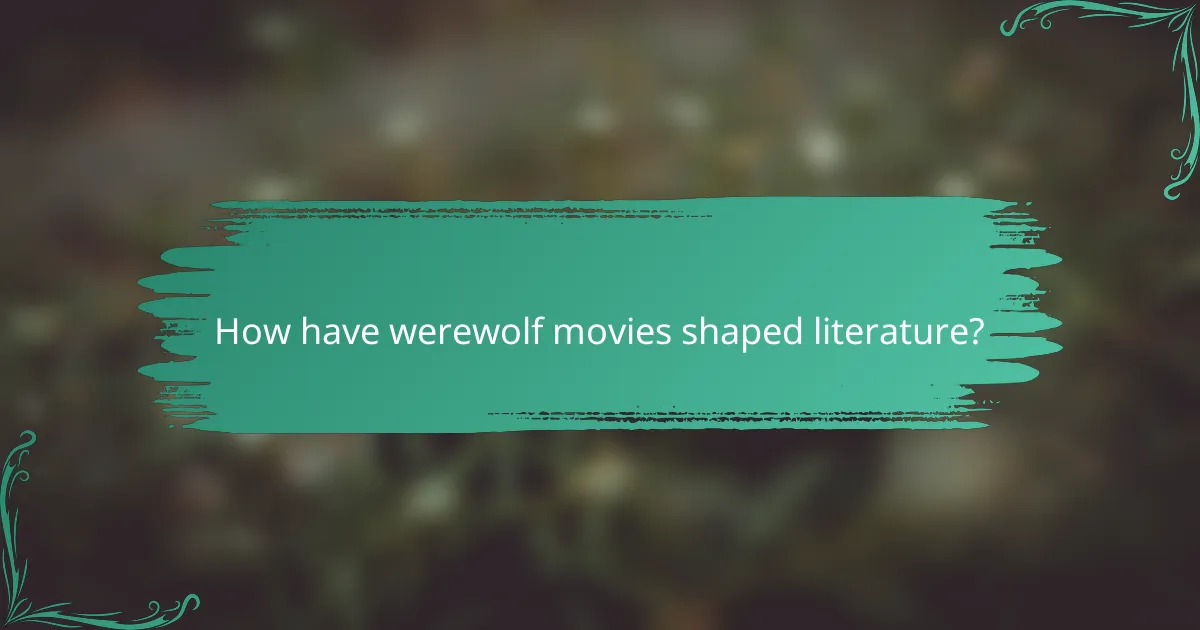Werewolf movies have left a lasting impact on modern horror and beyond, introducing intricate characters and innovative storytelling that delve into themes of transformation and duality. These motifs not only enrich the horror genre but also inspire narratives in fantasy and drama, reflecting the struggle between one’s true nature and external pressures. Additionally, the influence of werewolf films extends into the realm of video games, where their cinematic elements enhance interactive experiences in titles like “The Wolf Among Us.”

How have werewolf movies influenced modern horror films?
Werewolf movies have significantly shaped modern horror films by introducing complex characters, innovative narratives, and groundbreaking visual effects. Their themes of transformation and duality resonate across various horror subgenres, inspiring filmmakers to explore deeper psychological and societal issues.
Inspiration for character development
Werewolf films often feature protagonists grappling with their dual nature, which has influenced character development in modern horror. This internal conflict allows for rich storytelling, as characters navigate their human emotions alongside their monstrous instincts. For instance, films like “An American Werewolf in London” showcase characters who struggle with their transformations, prompting audiences to empathize with their plight.
Modern horror films have adopted this approach, creating multi-dimensional characters who face moral dilemmas and personal demons. This complexity enhances viewer engagement and adds depth to the horror experience.
Impact on narrative structure
The narrative structure of werewolf movies often incorporates themes of transformation and the loss of control, which have been adopted by contemporary horror filmmakers. These stories typically follow a journey of self-discovery intertwined with horror elements, allowing for unexpected plot twists and character arcs. This structure keeps audiences on edge, as seen in films like “The Howling,” where the protagonist’s journey reveals deeper societal fears.
Modern horror often mirrors this structure by blending genres, such as psychological thriller with supernatural elements, creating a more immersive experience. Filmmakers can experiment with pacing and perspective, enhancing the overall tension and suspense.
Visual effects advancements
Werewolf movies have driven advancements in visual effects, particularly in the portrayal of transformations. The groundbreaking work in films like “The Howling” and “An American Werewolf in London” set new standards for practical effects, influencing how creatures are depicted in horror. These films showcased the potential of makeup and animatronics, paving the way for CGI innovations in later horror films.
Today, filmmakers continue to push the boundaries of visual effects, often blending practical effects with CGI to create more realistic and terrifying creatures. This evolution allows for a more immersive horror experience, as audiences are drawn into the unsettling transformations that werewolf films first popularized.

What themes from werewolf movies appear in other genres?
Themes from werewolf movies often explore transformation, identity, and the struggle between inherent nature and external influences. These motifs resonate across various genres, influencing narratives in horror, fantasy, and even drama.
Transformation and identity
Transformation is a central theme in werewolf films, symbolizing the struggle between one’s primal instincts and societal expectations. This theme is prevalent in genres like fantasy and drama, where characters undergo significant changes that challenge their identities.
For example, in fantasy literature, characters may transform into creatures or face magical curses that force them to confront their true selves. This mirrors the werewolf’s duality, highlighting the tension between human and beast.
Nature vs. nurture debates
The nature vs. nurture debate is a recurring theme in werewolf narratives, questioning whether behavior is determined by genetics or environment. This theme extends to psychological thrillers and dramas, where characters grapple with their upbringing versus their innate tendencies.
In many stories, the werewolf’s transformation can be seen as a metaphor for uncontrollable urges shaped by external factors, such as trauma or societal pressure. This exploration invites audiences to consider how much of their identity is shaped by nature and how much is influenced by their surroundings.

Which werewolf movies have inspired video games?
Several werewolf movies have significantly influenced the development of video games, particularly in narrative and gameplay mechanics. Titles like “The Wolf Among Us” and “Blood of the Werewolf” showcase how cinematic elements from these films translate into engaging interactive experiences.
The Wolf Among Us
“The Wolf Among Us,” developed by Telltale Games, draws inspiration from the comic series “Fables,” which incorporates fairy tale characters, including werewolves, into a gritty narrative. The game emphasizes storytelling and player choices, allowing users to navigate a dark, atmospheric world reminiscent of classic werewolf films.
Players engage in dialogue and make decisions that impact the story’s outcome, similar to the moral dilemmas faced by characters in werewolf cinema. The game’s art style and character designs reflect the aesthetic of traditional werewolf lore, enhancing the immersive experience.
Blood of the Werewolf
The game features a mix of combat and puzzle-solving, requiring players to utilize their werewolf abilities strategically. Its homage to werewolf mythology is evident in the design of enemies and environments, making it a unique addition to the genre inspired by cinematic werewolf themes.

How do werewolf movies compare to vampire films?
Werewolf movies and vampire films differ significantly in themes, character portrayal, and audience appeal. While both explore supernatural transformations and the duality of human nature, werewolf narratives often emphasize the struggle against primal instincts, whereas vampire stories frequently delve into seduction and immortality.
Differences in mythology
The mythology surrounding werewolves typically involves a curse or a transformation triggered by the lunar cycle, often portraying the werewolf as a tragic figure battling their inner beast. In contrast, vampire lore is rich with themes of seduction, immortality, and the need for blood, often depicting vampires as more sophisticated and alluring beings.
Additionally, werewolves are often tied to folklore from various cultures, such as the European legends of lycanthropy, while vampire myths have roots in many traditions, including Slavic and Mediterranean cultures. This cultural diversity influences how each creature is represented in films.
Audience reception trends
Audience reception of werewolf movies tends to fluctuate, often peaking during periods of horror film popularity, while vampire films have maintained a more consistent appeal over decades. Werewolf films, such as “An American Werewolf in London,” often receive acclaim for their special effects and transformation sequences, but they can struggle to find a broad audience compared to the enduring fascination with vampires.
In recent years, the rise of vampire-themed series like “Twilight” and “True Blood” has overshadowed werewolf narratives, leading to a perception that vampire stories resonate more with contemporary audiences. However, films like “The Wolfman” and “Dog Soldiers” have shown that there is still a dedicated fan base for werewolf stories, especially when they incorporate strong character development and innovative storytelling.

What are the key elements of werewolf mythology in film?
Werewolf mythology in film typically revolves around transformation, curses, and the struggle between human and beast. These elements create a compelling narrative that explores themes of identity, fear, and the primal instincts within us.
Full moon transformation
The full moon transformation is a central element of werewolf mythology, marking the time when a human becomes a wolf. This transformation often symbolizes the loss of control and the unleashing of one’s darker nature. In films, this change can be depicted through special effects, showcasing the physical and emotional turmoil of the character.
Typically, the transformation is portrayed as painful and chaotic, emphasizing the struggle between the human and animalistic sides. For example, characters may experience intense physical changes, such as elongating limbs and facial features morphing, often accompanied by howling and violence.
Curse and contagion
The curse and contagion aspect of werewolf mythology often involves a character being afflicted by a supernatural curse, usually from a bite or scratch from another werewolf. This element introduces themes of inevitability and the fear of losing one’s humanity. In many films, the curse is portrayed as a burden that the character must learn to manage or overcome.
Additionally, the contagion aspect can lead to a spreading of the curse, creating a sense of urgency and danger. Characters may grapple with the moral implications of their actions, as they risk turning loved ones into werewolves. This dynamic adds depth to the narrative, showcasing the struggle between the desire for connection and the fear of harming others.

How have werewolf movies shaped literature?
Werewolf movies have significantly influenced literature by inspiring themes, character archetypes, and narrative structures across various genres. Their portrayal of transformation, duality, and the struggle between human and beast resonates deeply in storytelling, leading to a rich tapestry of literary works.
Influence on horror novels
Werewolf movies have left a lasting mark on horror novels, often introducing elements of suspense and psychological tension. Authors frequently explore the theme of transformation, using werewolves as metaphors for inner conflict and societal fears. Notable examples include works like “The Wolfen” by Whitley Strieber and “Bitten” by Kelley Armstrong, which delve into the complexities of lycanthropy.
Many horror novels now incorporate werewolf lore, blending traditional folklore with modern storytelling techniques. This fusion creates a fresh take on the genre, appealing to both classic horror fans and new readers. The dual nature of werewolves often serves as a vehicle for exploring deeper themes such as identity and morality.
Integration into fantasy genres
In fantasy literature, werewolves have become integral characters, often depicted as noble or tragic figures. Their presence enriches the narrative, providing a unique blend of magic and realism. Series like “The Last Werewolf” by Glen Duncan showcase how these creatures can embody both heroism and monstrosity, appealing to a wide audience.
Furthermore, werewolves often interact with other mythical beings, creating complex worlds filled with intrigue and adventure. This integration allows authors to explore themes of loyalty, power, and the supernatural, making werewolves a versatile element in fantasy storytelling. Readers are drawn to the rich lore surrounding these creatures, enhancing the overall depth of the genre.

What emerging trends are seen in recent werewolf films?
Recent werewolf films are increasingly blending genres, incorporating elements from horror, drama, and even comedy. This evolution reflects a growing interest in character-driven narratives and social commentary, moving beyond traditional horror tropes.
Blending Genres
Modern werewolf films often mix horror with other genres, such as romance or thriller. This blending allows filmmakers to explore deeper emotional themes while maintaining suspense and excitement. For instance, films like “The Wolf of Snow Hollow” combine dark humor with horror elements, appealing to a broader audience.
Character Development
Recent werewolf movies focus more on character arcs and personal struggles rather than just the transformation itself. This shift emphasizes the psychological aspects of being a werewolf, exploring themes of identity and morality. Viewers are drawn to stories that delve into the human condition, making the supernatural elements more relatable.
Social Commentary
Many contemporary werewolf films incorporate social issues, such as mental health or societal alienation. By using the werewolf as a metaphor, filmmakers can address real-world problems in a compelling way. For example, “Ginger Snaps” addresses themes of adolescence and female empowerment through its werewolf narrative.
Visual Effects and Technology
Advancements in visual effects have significantly enhanced the portrayal of werewolves on screen. Modern films utilize CGI and practical effects to create more realistic transformations and creature designs. This technological evolution allows for more creative storytelling, making the werewolf experience more immersive for audiences.
